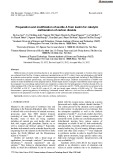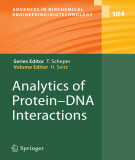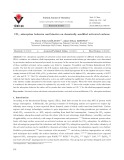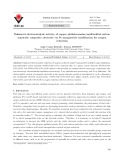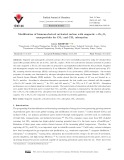
Activated carbon modification
-
In this research, in an attempt to make use of the kaolin resources in Vietnam, we present a synthetic process of zeolite A via hydrothermal from kaolinite, together with the modification process of zeolite A using different metallic cations. The characteristics of the prepared zeolite LTAs such as chemical composition and crystalline structure, as well as their catalytic activity in the methanation reaction of carbon dioxide (CO2) to methane (CH4) were extensively investigated.
 8p
8p  dianmotminh02
dianmotminh02
 03-05-2024
03-05-2024
 3
3
 1
1
 Download
Download
-
Ebook "Analytics of Protein–DNA interactions (Advances in biochemical engineering/biotechnology, Volume 104)" focuses on the fascinating possibilities that emerged during the last years to study protein–DNA interactions in vitro. As an essential part of transcriptional activity during development and in tumorgenesis a separate chapter describing the analysis of DNA modification especially methylation of cytosines at their carbon-5 position was included.
 212p
212p  manmanthanhla0201
manmanthanhla0201
 27-02-2024
27-02-2024
 4
4
 2
2
 Download
Download
-
The aim of the work "Activated Carbon Prepared from Rice Husk: Nitric Acid Modification and BTX Adsorption" is to evaluate the elimination of BTX by activated carbons prepared from rice husk. The effects of surface modification on the specific surface area, pore texture and adsorption capacity of the AC samples have been examined.
 5p
5p  runordie3
runordie3
 27-06-2022
27-06-2022
 8
8
 2
2
 Download
Download
-
In the work "Adsorption behavior of Pb(II) in aqueous solution using coffee husk-based activated carbon modified by nitric acid", activated carbon (AC) was prepared from coffee husk and modified by nitric acid for effective lead ions removal from aqueous solution. The as-prepared samples have uniform particles size, developed surface area and contain acidic surface functional groups. Nitric acid modification showed a pronounced effect on improving Pb(II) adsorption capacity.
 10p
10p  runordie3
runordie3
 27-06-2022
27-06-2022
 9
9
 2
2
 Download
Download
-
CO2 adsorption capacities of activated carbon-based adsorbents subjected to different treatments, such as HNO3 oxidation, air oxidation, alkali impregnation, and heat treatment under helium gas atmosphere, were determined by gravimetric analyses and reported previously by our group. In the current work, the experimental adsorption isotherms of these modified activated carbon samples were fitted to Langmuir, Freundlich, and Dubinin–Radushkevich (D-R) models.
 12p
12p  langthannam
langthannam
 29-12-2021
29-12-2021
 7
7
 0
0
 Download
Download
-
Enhanced electrocatalytic reduction of oxygen is achieved using Pt nanoparticle-modified copper phthalocyanine-multiwalled carbon nanotube (PtNPs/CuPc-CNT) composite film on a glassy carbon electrode (PtNPs/CuPcCNT/GCE). The PtNPs/CuPc-CNT/GCE surface is characterized by scanning electron microscopy, transmission electron microscopy, electrochemical impedance spectroscopy, X-ray photoelectron spectroscopy, and X-ray diffraction. The electrocatalytic activity of composite electrodes in the oxygen reduction reaction is investigated by cyclic voltammetry and rotating-disk electrode measurements.
 16p
16p  tudichquannguyet
tudichquannguyet
 29-11-2021
29-11-2021
 7
7
 1
1
 Download
Download
-
In this study, a novel and effective electrochemical sensor for determination of dopamine (DA) was successfully developed by the modification of a glassy carbon electrode (GCE) using Pd nanoparticles deposited on (3- aminopropyl)triethoxysilane functionalized nanoceria (Pd@CeO2 -APTES) and nafion used as a protective membrane. The synthesized nanocomposites were evaluated using X-ray diffraction, high-resolution transmission electron microscopy, and Fourier transform infrared spectroscopy.
 12p
12p  tudichquannguyet
tudichquannguyet
 29-11-2021
29-11-2021
 6
6
 0
0
 Download
Download
-
Magnetic and nonmagnetic activated carbons (ACs) were successfully prepared by using AC obtained from spent coffee grounds (SCGs) for use in CO2 and CH4 capture. SCGs were activated by chemical activation to produce ACs and a magnetic α-Fe2O3/AC composite was prepared by coprecipitation method from the ACs produced. Magnetic and nonmagnetic samples were characterized by X-ray diffraction (XRD), Fourier transform infrared spectroscopy (FTIR), scanning electron microscopy (SEM), and energy dispersive X-ray spectrometry (EDX) techniques.
 18p
18p  tudichquannguyet
tudichquannguyet
 29-11-2021
29-11-2021
 10
10
 1
1
 Download
Download
-
Over the past few decades, metal–organic frameworks (MOFs) have proved themselves as strong contenders in the world of porous materials, standing alongside established classes of compounds such as zeolites and activated carbons.
 16p
16p  vijiraiya2711
vijiraiya2711
 27-05-2020
27-05-2020
 8
8
 0
0
 Download
Download
-
The electro-oxidation of formic acid (an essential reaction in direct formic acid fuel cells) is a challenging process because of the deactivation of anodes by the adsorption of the poisoning intermediate carbon monoxide (CO). Pt electrodes in two geometries (planar and nanohole-array) were modified by the electrodeposition of manganese oxide nanorods (nano-MnOx). The modified Pt electrodes were then tested for their electrocatalytic activity through the electro-oxidation of formic acid in a solution of pH 3.45. Two oxidation peaks (I d p and I ind p ) were observed at 0.2 and 0.
 7p
7p  kethamoi1
kethamoi1
 20-11-2019
20-11-2019
 21
21
 0
0
 Download
Download
-
The potential of using anaerobic digestion for the treatment of poultry blood has been evaluated in batch assays at the laboratory scale and in a mesophilic semi-continuous reactor. The biodegradability test performed on residual poultry blood was carried out in spite of high inhibitory levels of acid intermediaries. The use of activated carbon as a way to prevent inhibitory conditions demonstrated the feasibility of attaining anaerobic digestion under extreme ammonium and acid conditions.
 11p
11p  kequaidan1
kequaidan1
 16-11-2019
16-11-2019
 24
24
 0
0
 Download
Download
-
Activated carbon (AC) has been proven to be an effective adsorbent for the removal of a variety of pollutants. AC is extensively used for adsorption because its high surface area is welldeveloped internal micro porosity. The objective of this study is to determine the optimal condition of the surface modification process of activated carbon from rice husk (ACRH) using HNO3.
 8p
8p  cumeo3000
cumeo3000
 01-08-2018
01-08-2018
 37
37
 1
1
 Download
Download
-
Activated carbon (AC) from coconut shells is used as support for platinum catalysts. A series of catalysts based on platinum and Pt doped Sn were prepared by impregnation on different supports like AC and SiO2. It was shown that the nature of the support has a significant influence on the activity and selectivity to alkenes of the catalysts in the dehydrogenation of nhexane to alkenes. The higher activity and selectivity of the carbon supported platinum catalyst can be explained by higher dispersion of platinum particles of the catalysts.
 5p
5p  uocvong01
uocvong01
 24-09-2015
24-09-2015
 48
48
 3
3
 Download
Download
-
The synthesis and characterization of activated carbons (ACs) obtained from lignocellulosic precursors is a topic widely studied by a number of researchers worldwide. In the last decades, an increase has been observed in the number of publications related to the synthesis, modification, characterization and application of ACs obtained from lignocellulosic materials. Particularly, the applications of these carbons are primarily focused in the removal of several inorganic and organic pollutants from water and wastewaters....
 100p
100p  qsczaxewd
qsczaxewd
 25-09-2012
25-09-2012
 51
51
 7
7
 Download
Download
CHỦ ĐỀ BẠN MUỐN TÌM








